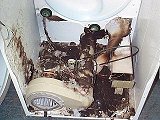
 One of the ways that dryers can start household fires is by igniting the excess lint that accumulates around the motor, burner shroud (for gas dryers) and cabinet interior. Lint is composed of very small, dry clothing particles which includes cotton and polyesters–both very good fires starters. Polyesters are particularly pernicious fires starters and are very difficult to extinguish once they ignite. Polyesters, vinyl in particular, pose another fire hazard when used as vent hoses, which we’ll talk more about later in this article.
One of the ways that dryers can start household fires is by igniting the excess lint that accumulates around the motor, burner shroud (for gas dryers) and cabinet interior. Lint is composed of very small, dry clothing particles which includes cotton and polyesters–both very good fires starters. Polyesters are particularly pernicious fires starters and are very difficult to extinguish once they ignite. Polyesters, vinyl in particular, pose another fire hazard when used as vent hoses, which we’ll talk more about later in this article.
There are three things you can do to prevent the threat of fire from accumulated lint inside your dryer. First, clean your lint filter before every load. This will minimize the lint blow-by around the filter and save energy by helping the dryer run more efficiently.
Second, inspect your lint filter each time you pull it out. If you see any rips or distortions in the screen, replace the filter immediately.
Finally, have your dryer professionally disassembled and cleaned annually. A thorough professional cleaning removes accumulated lint and dirt from the dryer cabinet interior, motor, and burner or heating elements. If you’d like to do this cleaning yourself, this page will help you disassemble your dryer. In addition to substantially reducing the risk of dryer fires, this type of regular cleaning will help the drum bearings and rollers last longer, preventing or minimizing future service calls. Many dryer installations use the common, cheap white vinyl vent hose for the dryer exhaust. These hoses were never UL-approved for dryer installations and are increasingly being recognized by local building codes as fire hazards.
 The American Household Appliance Manufacturers Association (AHAM) recommends the use of rigid aluminum ducts, such as shown here. For any dryer, but especially gas dryers, white vinyl vent hose should never be used and if yours has this installed on it, replace it ASAP with approved materials.
The American Household Appliance Manufacturers Association (AHAM) recommends the use of rigid aluminum ducts, such as shown here. For any dryer, but especially gas dryers, white vinyl vent hose should never be used and if yours has this installed on it, replace it ASAP with approved materials.
There’s alot more to dryer venting that just running a collapsible hose. In addition to the type of allowable materials for the vent, there are all kinds of specifications for length and the number of allowable elbows and bends. All this is to ensure that air can move through the vent with sufficient velocity to prevent lint accumulation and dry the clothes in the shortest amount of time possible. Read more about dryer venting on this page.
 One of the biggest causes of vent hose fires is the ignition of accumulated lint inside the vent hose. Lint gets caught in the folds and creases and sticks there because of the humidity. Over time, the lint builds up to such a degree that the dryer cannot exhaust properly. This results in increased drying times initially and, ultimately, in a fire. Once a fire starts in a vinyl vent hose, the hose itself ignites and burns vigorously creating a fire that is very difficult to extinguish. The defense here is to clean your dryer vent out twice a year using a dryer vent lint brush.
One of the biggest causes of vent hose fires is the ignition of accumulated lint inside the vent hose. Lint gets caught in the folds and creases and sticks there because of the humidity. Over time, the lint builds up to such a degree that the dryer cannot exhaust properly. This results in increased drying times initially and, ultimately, in a fire. Once a fire starts in a vinyl vent hose, the hose itself ignites and burns vigorously creating a fire that is very difficult to extinguish. The defense here is to clean your dryer vent out twice a year using a dryer vent lint brush.
For more information on your dryer or to order parts, click here.


